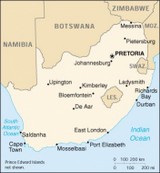Main menu:
South Africa
Introduction |
||
Flag: |
|
|
Card: |
||
Hintergrund: |
After the British seized the Cape of Good Hope area in 1806, many of the Dutch settlers (the Boers) trekked north to found their own republics. The discovery of diamonds (1867) and gold (1886) spurred wealth and immigration and intensified the subjugation of the native inhabitants. The Boers resisted British encroachments, but were defeated in the Boer War (1899-1902). The resulting Union of South Africa operated under a policy of apartheid - the separate development of the races. The 1990s brought an end to apartheid politically and ushered in black majority rule. |
|
Geography |
||
Location: |
Southern Africa, at the southern tip of the continent of Africa |
|
Coordinates: |
29° 00' S, 24° 00' E |
|
Map references: |
Africa |
|
Area: |
total: 1,219,912 sq km |
|
Coastline: |
2.798 Km |
|
Climate: |
mostly semiarid; subtropical along east coast; sunny days, cool nights |
|
Terrain: |
vast interior plateau rimmed by rugged hills and narrow coastal plain |
|
Elevation extremes: |
lowest point: Atlantic Ocean 0 m |
|
Natural resources: |
gold, chromium, antimony, coal, iron ore, manganese, nickel, phosphates, tin, uranium, gem diamonds, platinum, copper, vanadium, salt, natural gas |
|
Natural hazards: |
prolonged droughts |
|
Geography - note: |
South Africa completely surrounds Lesotho and almost completely surrounds Swaziland |
|
People |
||
Population: |
43,586,097 (July 2001 est.) |
|
Note: |
South Africa took a census October 1996 which showed a population of 40,583,611 (after an official adjustment for a 6.8% underenumeration based on a postenumeration survey); estimates for this country explicitly take into account the effects of excess mortality due to AIDS; this can result in lower life expectancy, higher infant mortality and death rates, lower population and growth rates, and changes in the distribution of population by age and sex than would otherwise be expected (July 2001 est.) |
|
Nationality: |
noun: South African(s) |
|
Ethnic groups: |
black 75.2%, white 13.6%, Colored 8.6%, Indian 2.6% |
|
Religions: |
Christian 68% (includes most whites and Coloreds, about 60% of blacks and about 40% of Indians), Muslim 2%, Hindu 1.5% (60% of Indians), indigenous beliefs and animist 28.5% |
|
Languages: |
11 official languages, including Afrikaans, English, Ndebele, Pedi, Sotho, Swazi, Tsonga, Tswana, Venda, Xhosa, Zulu |
|
Government |
||
Country name: |
conventional long form: Republic of South Africa |
|
Government type: |
Republic |
|
Capital: |
Pretoria |
|
Note: |
Cape Town is the legislative center and Bloemfontein the judicial center |
|
Administrative divisions: |
9 provinces; Eastern Cape, Free State, Gauteng, KwaZulu-Natal, Mpumalanga, North-West, Northern Cape, Northern Province, Western Cape |
|
Independence: |
31 May 1910 (from UK) |
|
National holiday: |
Freedom Day, 27 April (1994) |
|
Judicial branch: |
Constitutional Court; Supreme Court of Appeals; High Courts; Magistrate Courts |
|
Flag description: |
two equal width horizontal bands of red (top) and blue separated by a central green band which splits into a horizontal Y, the arms of which end at the corners of the hoist side; the Y embraces a black isosceles triangle from which the arms are separated by narrow yellow bands; the red and blue bands are separated from the green band and its arms by narrow white stripes |
|
Note: |
prior to 26 April 1994, the flag was actually four flags in one - three miniature flags reproduced in the center of the white band of the former flag of the Netherlands, which had three equal horizontal bands of orange (top), white, and blue; the miniature flags were a vertically hanging flag of the old Orange Free State with a horizontal flag of the UK adjoining on the hoist side and a horizontal flag of the old Transvaal Republic adjoining on the other side |
|
Economy |
||
Economy - overview: |
South Africa is a middle-income, developing country with an abundant supply of resources, well-developed financial, legal, communications, energy, and transport sectors, a stock exchange that ranks among the 10 largest in the world, and a modern infrastructure supporting an efficient distribution of goods to major urban centers throughout the region. However, growth has not been strong enough to cut into the 30% unemployment, and daunting economic problems remain from the apartheid era, especially the problems of poverty and lack of economic empowerment among the disadvantaged groups. Other problems are crime, corruption, and HIV/AIDS. At the start of 2000, President MBEKI vowed to promote economic growth and foreign investment, and to reduce poverty by relaxing restrictive labor laws, stepping up the pace of privatization, and cutting unneeded governmental spending. |
|
Agriculture - products: |
corn, wheat, sugarcane, fruits, vegetables; beef, poultry, mutton, wool, dairy products |
|
Exports: |
$30.8 billion (f.o.b., 2000 est.) |
|
Exports - commodities: |
gold, diamonds, other metals and minerals, machinery and equipment |
|
Imports - partners: |
Germany, US, UK, Japan |
|
Currency: |
rand (ZAR) |
|
Currency code: |
ZAR |
|
Transportation |
||
Railways: |
total: 21,431 km |
|
Highways: |
total: 358,596 km |
|
Ports and harbors: |
Cape Town, Durban, East London, Mosselbaai, Port Elizabeth, Richards Bay, Saldanha |
|
Coffee |
||
Coffee type: |
Arabica |
|
Harvest time: |
Juni bis September |
|
Shippment time: |
Oktober bis May |
|
Crop volumen: |
ca. 8.000 Bags (of each 60 kg) |
|
Fermentation: |
yes |
|
Processing: |
wet |
|
Sorting: |
by hand |
|












